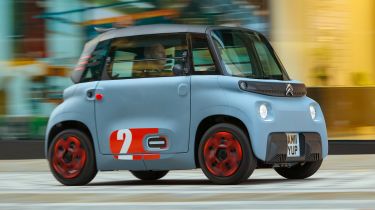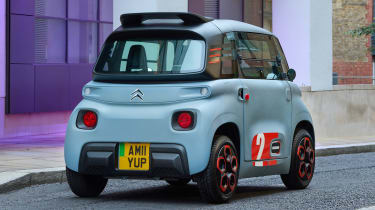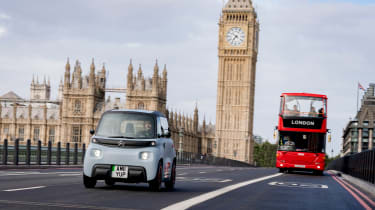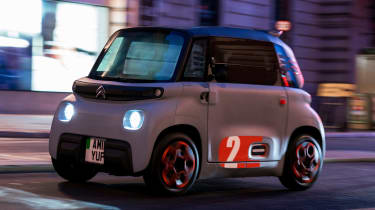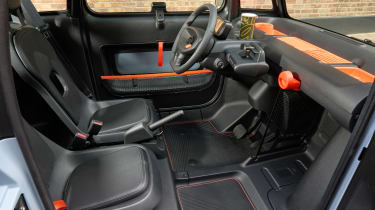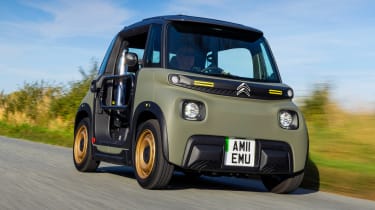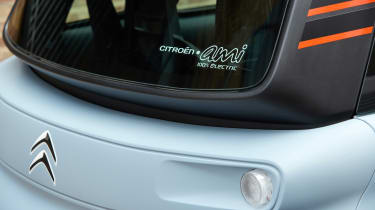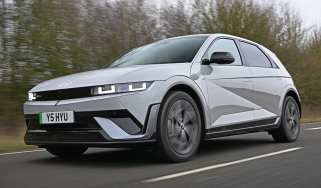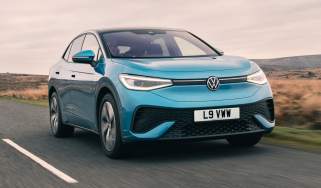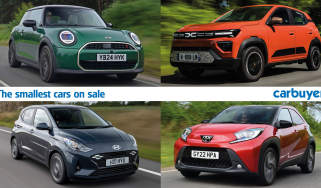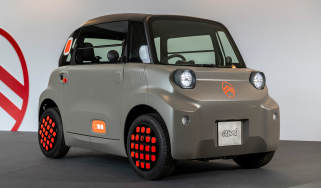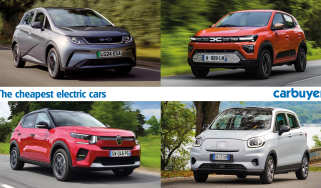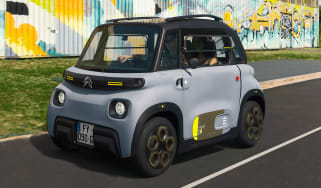Citroen Ami hatchback review
"The Citroen Ami is an intriguing ultra-compact electric vehicle designed to be incredibly cheap to buy and run"
Pros
- Affordable
- Manoeuvrable
- Relatively spacious
Cons
- Slow
- Lacks refinement
- Limited safety kit
Verdict – is the Citroen Ami a good car?
The Citroen Ami isn’t technically a car at all, but as one of the cheapest electric cars available to get around the city, this quadricycle could prove an attractive proposition. The Ami Buggy will also be a tempting choice for those after a bit of fun in fair weather, though it’s even more limited on practicality and isn’t the one to go for if you’re likely to get caught in a downpour.
Overall, the Citroen Ami is worth your consideration if you need to get from A to B in the city and don’t want to use public transport, and it’s worth looking out for exceptionally cheap finance deals through the brand’s website if you fancy giving it a go.
Citroen Ami models, specs and alternatives
The Citroen Ami wasn't originally going to be sold in the UK but serious interest from British buyers persuaded the French manufacturer to sell it here too. Technically a quadricycle, the Ami is a two-seat microcar that's designed for use in cities only, rather like the old Renault Twizy.
The Ami was designed to be cheap to produce so that buying and leasing, or even hiring by the minute using a car sharing app, are all affordable alternatives to public transport. In France, the Ami costs just over £7,000 after a government grant, while a lease costs from around £30 a month. Hiring one costs just 23p per minute. In some European nations, it can be driven by anyone aged 14 or over and without a driving licence but UK drivers will need to be older than 17 and hold a provisional licence.
 Top 10 best small electric cars 2025
Top 10 best small electric cars 2025
It’s a little more expensive in the UK, with prices starting just under £8,000, while the doorless, off-road style Ami Buggy is nearer £10,500, but that’s still several thousand less than any conventional car, and running costs are absolutely minuscule.
There's a surprising amount of room inside the Ami for two adults, thanks to its square proportions and fairly tall roof. It feels basic inside, with hard plastics and seats like those you'd find in a bus or taxi, but everything is neatly designed and the car feels fun. Extra space and large cubbies also makes up for the lack of a proper boot, so there's room for shopping or carry-on luggage. The Ami isn't designed for long trips, just short hops across town.
Power comes from an 8bhp electric motor supplied by a 5.5kWh battery. This can be charged using a domestic plug in around three hours and provides a range of up to 46 miles – easily enough to get across a city the size of London. With just 458kg to get moving, the motor does a reasonable job but the Ami's top speed is limited to just 28mph. This makes it suitable for driving in built-up areas only; find yourself on a road with a speed limit of even 40mph and the Ami starts to feel out of its depth.
Citroen offers several versions of the Ami, but the differences are limited to the exterior styling. All models are painted the same shade of greyish-brown (replacing the original Ami Blue in 2024) but you can pay extra to have orange, blue or grey styling details. Sitting at the top of the range is the Ami Buggy, which is styled to look like a tough off-roader, with steel tubes in place of doors and a mini roof spoiler. 2024 saw the introduction of the Ami Peps, which adds some of the Buggy’s styling cues and unique decals.
Citroen offered a single-seater delivery version called the Ami Cargo, but this was replaced in 2024 by an optional ‘cargo kit’ that can be ordered with any regular Ami. The passenger seat is replaced by a cargo storage area, designed for urban deliveries.
The Ami isn’t really a proper rival to cars like the Dacia Sandero, or even the electric Dacia Spring, but anyone looking to commute without donning a helmet or braving wintry weather (Ami Buggy excepted) could find the Ami an appealing solution. It's one of the very cheapest ‘cars’ to own (or hire) in the UK.
Range, charging & running costs
If you’re prepared to suspend your disbelief for a moment then the Citroen Ami is Britain’s least expensive new car, costing under £8,000 brand new, undercutting a conventional cheap car like a Dacia Sandero by more than £5,000. While some of that low cost comes from not having to meet the same safety standards and other legislation of most other cars, it’s also because every aspect of its design is aimed at saving money. This doesn't just include running costs but even the cost of repairs; the body panels and parts have been engineered to be as cheap and easy to replace as possible. Even its nose and tail are identical for this reason.
As a fully electric vehicle, the cost of charging the Ami will depend on your electricity tariff or the public charger you use. However, the 5.5kWh battery is tiny compared to most models – even the Dacia Spring has a 27kWh battery – so a full charge won't cost very much. Once fully charged, the Ami can travel up to 46 miles. The European Ami we drove came with a domestic plug, taking around three hours to charge. UK cars come with a Type 2 adapter, making it easy to use public chargers or a home wallbox.
Electric motor, drive & performance
Weighing just 458kg and measuring 2.4 metres in length, it's best not to compare the way the Ami drives with other city cars. The Ami is actually a quadricycle, in the same way as the Renault Twizy, and its motor has just 8bhp. Unlike the Twizy, this is sent to the front wheels and gives the Ami a top speed of 28mph.
This means the Ami feels at home on city streets and out of its depth if you accidentally stray onto a faster road. Up to its top speed the Ami feels relatively nippy thanks to its light weight, while the no-frills approach to refinement makes 25mph feel more like twice the speed. Negatives include a bouncy ride and vague, unassisted steering that's surprisingly heavy given the Ami's size.
The Ami still manages to be great fun in the right environment, with its tiny footprint and 7.2-metre turning circle helping it run rings around larger cars in congested streets. Excellent visibility makes it easy to spot gaps normally reserved for motorbikes and park in impossibly tight spaces. We don't expect drivers to take long journeys in the Ami and shorter trips around town should prove great fun.
The Citroen Ami Buggy, with bars rather than doors, is even more of a laugh – at least in warmer weather. Like the semi-doorless Twizy, the extra rush of wind and seeing the ground whizz by adds to the fun factor, and the low top speed means it doesn’t feel as risky to drive as you might think. But if you’re at all intending to drive an Ami over winter, it’s probably one to miss.
Interior & comfort
The Ami manages to look futuristic but manual side windows that simply flip up and are held with a latch are decidedly old-fashioned. Small circular door mirrors sit on manually adjusted stalks and the passenger seat is fixed in place for simplicity. The driver's seat does slide, of course, making it straightforward to find a comfortable driving position.
The seats themselves are quite hard, but they appear easy to clean and tough. They've clearly been designed for short stints and car sharing schemes, where they will be subject to lots of wear and tear from drivers hiring the Ami in a similar fashion to electric scooters.
Interior quality could be the biggest shock for owners used to a more conventional model because cheap, hard plastics are used throughout. It's cleverly designed and quirky but definitely not luxurious; an infotainment system is replaced with a mount for your own smartphone.
It's worth remembering you can buy an entire Ami for less than the cost of the lavish optional extras offered in luxury cars. We like the bright splashes of colour inside – the Ami Buggy gets its own bright, hi-viz yellow detailing – and young drivers are less likely to baulk at the fabric pull straps used in place of traditional door handles.
Practicality & boot space
The first thing you'll notice is that one door is hinged from the front, while the other is hinged at the rear – a cost-saving measure that allows both doors to be the same part. It's also amazing how much room there is inside the two-seater because the wheels are pushed out to the corners. The Ami's relatively high roofline also means there's plenty of headroom and lots of light floods in thanks to a standard glass roof. Many buyers will prefer the idea of sitting next to their passenger too; in the Twizy, the passenger seat is behind the driver’s.
There isn't a traditional boot in the Ami, just some space to fit items behind the seats and a large passenger footwell that can accommodate a small travel bag or some shopping. So long as you don't mind sitting with your luggage, there's a reasonable amount of space. Compared with a scooter, the Ami will at least keep you dry and you don't have to bother with leathers and a helmet like you would with a motorbike.
Given the standard car is already relatively limited in its practicality, the doorless Ami Buggy really is more of a toy than a vehicle. Staying warm and dry is down to your clothing choice and you probably don’t want to leave anything loose in the cabin – not just for security reasons, but to avoid anything flying out of the car during enthusiastic cornering.
Citroen offered a variant called the Ami Cargo for the first few years of production, which replaced the passenger seat with a large storage space for cargo. It was intended for short-distance deliveries, but Citroen has decided to discontinue this model in favour of the My Ami Cargo Kit; this optional extra allows any regular Ami to be easily converted into a cargo-carrying version at a cost of around £260.
Reliability & safety
The Citroen Ami has not only been designed to be simple but also robust enough to cope with car sharing; it feels tough as a result. With just a battery, electric motor and simple digital instrument readout, there should be very little to go wrong. If there is a piece of broken trim or the bodywork gets dinged, parts should be easy and cheap to replace.
As it’s classed as a quadricycle, the Ami won't be subject to the same crash legislation as a model like the Dacia Sandero, and this goes hand-in-hand with its limited top speed. For this reason, the Ami can't be compared with most other cars but is most likely safer than being on two wheels. If you live in a congested city where hitting more than 20mph is a rarity, this is unlikely to be much of a concern but we'd avoid taking the Ami further afield.

